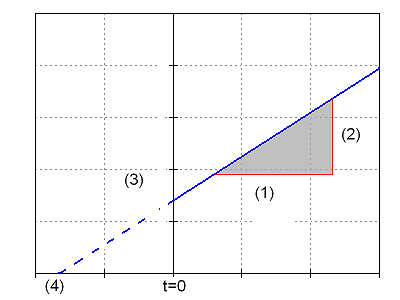User:Chris1727
=Sandbox=
Text
Kursiv
[math]x(t)=x_0 + vt[/math]
[math]\Delta x = v \Delta t[/math]
[math]v = \frac{x}{t}[/math]
[math]v = \frac{x_1 - x_0}{\Delta t}[/math]
[math]x_1(t) = x_2(t)[/math] </math> [math]x_1 + v_1 t = x_2 + v_2 t[/math]
[math]x_1 - x_2 = (v_2 - v_1) t[/math]
[math]t = \frac{x_1 - x_2}{v_2 - v_1} = \frac{173 m - 25 m}{28 km /h - 11 km/h}[/math]
= Aufgabe 1.10 =
b)
Schön, dass Sie an der Lösung dieser Aufgabe gearbeitet haben!--White Eagle 12:12, 22 October 2007 (CEST)
[math]x_1 = x_0 + v t[/math]
[math]x_1 = 47.7km + 45 \frac{m}{s} 4870s [/math]
[math]x_1 = 266.9km[/math]
Geschwindigkeit PKW
[math]v_2 = \frac{\Delta x }{\Delta t } = \frac{266.9km - 15.2km}{4800s} = 52.4 \frac{m}{s}[/math]
c)
aus b) folgt:
266.9km - 47.7km = 219.2km = Strecke des LKW
266.9km - 15.2km = 251.7km = Strecke des PKW
Übersetzung
It follows in this case:
[math]a =\frac{v}{t}[/math]
(Movement with constant acceleration from that rests)
If the venture has already at the beginning of the movement a beginning speed [math]v_0[/math] so the functional equation is
[math]v(t) = v_0 + a t[/math]
The graph is a postponed origin-straight
[math](1)\Delta t[/math]
[math](2)\Delta v[/math]
[math](3)v_0[/math]
[math](4) t_0[/math]
It tourns out for a>0 a movement with acceleration,for a = 0 a movement with constant speed and for a<0 a movement with constant delay(falling graph)
!Attention! This time the formula[math] a = \frac{v}{t}[/math] is wrong!!
To be used is:
[math]a = \frac{\Delta v}{\Delta t}[/math]
a is also the gradient of the line
Definition: The accleretation a is the gradient of the t-v-graph
The unit of the acceleration is m/s²
Problem 2.3: Accelerationtest
A testinstitution analyses the movement of a vehicle.The results are:
| Time t in s | Speed v in m/s | |||||||
|---|---|---|---|---|---|---|---|---|
| 0 | 5 | 10 | 60 | 80 | 100 | 110 | 120 | 130 |
| 0 | 1 | 2 | 12 | 12 | 12 | 8 | 4 | 0 |
a) Draw a t-v-diagramm! (10s=1 cm, 1m/s=1 cm) b) Name the type of movement in the particular timezones! c) Find out the accelerations by using the graph!

